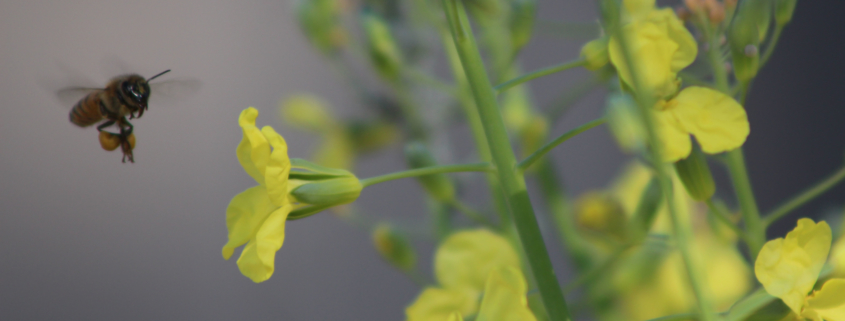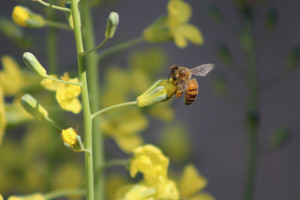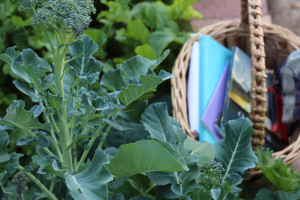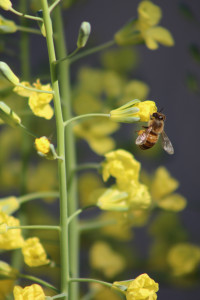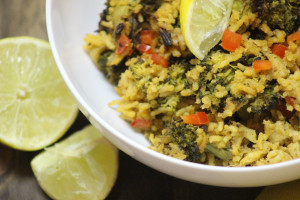When Broccoli Bolts Yellow Poems Sky: A Meditation on Patience, Grace, and Humility for Writers
Broccoli flowers are a riot of yellow. A yellow influenced by green that is bright like metal in the sun. When gardeners set out broccoli plants most never plan to see the flowers. When we eat broccoli florets we’re eating immature flower buds. So, when broccoli flowers come, waving their delicate yellow petal flags, they signal defeat. The broccoli has bolted or gone to seed, and the beautiful purple green buds that were plump and swelling just yesterday have burst into laughter. Though still editable, bolted broccoli’s flavor, texture, and use changes. Whatever promise of soup pots, quiche, or stir-fry that once hung on the gardener’s tongue evaporates.
The first time I grew broccoli I was heartbroken when the buds erupted into flowers. We have temperate winters here in Southern California’s Inland Valley, so I quickly cursed the foothills hugging us in for allowing warm air to sit and spoil my crop. I wanted broccoli for basmati rice and teriyaki sautés, not flowers.
That spring I decided I did not have the climate or the heart to garden through winter. But as a few seasons came and went, I began to rethink my relationship with nature and my garden. What if I viewed my garden as an act of witnessing nature as well as a place to grow food to feed my family? What if I approached gardening unselfishly—for the ants and aphids, grasshoppers and lizards, snails and hummingbirds, and also, for the broccoli flowers?
One morning I earnestly approached my poetry practice with the goal of witnessing nature. I decided against carrying my camera, the way I typically interacted artistically with my garden, and challenged myself to only rely on words to record what unfolded around me. I packed two notebooks, one for regular poems and another for Tanka poems, along with a couple of books of poetry, and a basket for harvesting.
Before I could settle into a seat I was heading back inside to gather my photography bag. The color of the broccoli did it. Greens, silvers, purples—and the sight of the bolted broccoli with yellow, ruffled hands out in prayer to the sky. This time, while seeking to stand witness of what unfolded in my garden, I found beauty in the yellow flowers, not defeat. Instead of viewing the broccoli flowers as a sign of the plant’s end of life, I saw it as the beginning of many more lives.
When a plant bolts, or goes to seed, it has come to the end of its life cycle and is diverting its energy towards producing seeds for progeny and no longer putting its energy into creating fruit. The fruit of the plant often becomes bitter, woody, less palatable—nature’s way of discouraging consumption and securing future crops.
Plants, like us, instinctively live to reproduce, to create future generations. Posterity. When viewed in this light, metallic yellow broccoli flowers boast their own promise of abundance.
It took me fifteen years to learn how to witness, be still, and translate what unfolds around me into poems. For years I struggled most with translating what I felt onto the page, and therefore, could not fully hear my voice. While waiting for my voice to develop, I translated what I observed in the world by creating mixed media art. During the same time, gardening fine-tuned my ability to be aware and witness the world around me. As a stewardess of nature I learned to listen and be keenly in tune with the seasons, the flora and fauna, and the weather around me.
I’ve come to realize what links the three practices—gardening, writing, art making—is the art of noticing, being a witness to life.
Poets, painters, and gardeners use the same eye, the same muscle, and call upon the same memories to remember, record, and celebrate what evolves around us. Our acts of creating poems, paintings, and garden beds push us beyond courage and passion and require us to look, notice, and then process what we have experienced. We then seek to translate and define for others what we have experienced, and how we have been moved and changed by witnessing.
We live and want others to live alongside us. We want others to share our awe, our wonder, our shock, joy, anger, and passion, so all of us feel acutely alive and connected.
At times we participate, join in, and ground ourselves with the world, but always, when we are succeeding at being our best artist selves, we are observing, watching, and noticing.
This way of living in tune and aware of what is around us requires muscle built from stillness, openness, and patience—virtues that help us develop into better artists by honing are ability to witness, translate, define, and pen our experiences into art. Living a deep and rich life requires actively choosing to be open to these virtues, and art is born in how we translate, define, and record them on the page.
This winter, I tell you, I am no longer a selfish gardener. The plants belong to the lizard and snails and birds as they belong to my family, my poems, and me. There is kindness in thinking of the bee hungry for nectar or the bird needing seeds during winter. Even the aphids have needs—why else would they cluster in large groups, crowding themselves in like a hug? Perhaps they are seeking comfort, warmth, and love, like all of us.
Developing sensitivity to the needs and voices of the tiniest creatures has taught me to be sensitive to the needs of my own voice. Letting my vegetables bolt and phase through a full life cycle is an act of grace and faith—an offer of goodwill to the tiny voices that also depend on my garden, and faith in the spent life of the plant. There will be more broccoli buds, more plants from the seeds spent plants sow.
I have learned to extend this same grace and faith to myself when I struggle on the page. Those moments when my voice winters deep inside my throat, and I wonder if ever more poems, more stories will come. When I am silent like winter I remember the favor of spring, the red riot of summer, and golden harvest of autumn. There will be more poems, more stories to tell from the seeds of goodwill I’ve sown—living I will eventually translate onto the page.
Spice Roasted Broccoli and Basmati Rice Casserole with Almond Cheese Sauce (Vegan)
-Inspired by Forks Over Knives
At the end of a long day of writing, reading, homeschooling the kids, I often need to dig into a warm bowl of comfort. A simple casserole, with easy ingredients to allow me to think about poems, novel plots, and homeschooling lessons while I cook is necessary. Roasting broccoli preserves its vitamins and minerals better than boiling, so I start there, with a long roast. Roasting vegetables also concentrates their sugars and heightens their flavors. I’ve got quite a love affair underway with broccoli this February, so heightened flavor suits me just fine. Here is a simple, but delicious recipe from one of my busy, winter weeknights. It is versatile, so feel free to use it as inspiration. There are notes below with suggestions.
Ingredients:
2 bunches of broccoli
Cumin, coriander, smoked salt
1 red bell pepper
3 stalks of celery
2-3 c. of cooked basmati rice
4 tbl. almonds, roasted and ground into flour
1 c. nutritional yeast
2 tbl. prepared mustard
¼ – ½ c. broth (vegetable for vegan, chicken for others) + more broth for cooking rice
Liquid smoke, a couple of drops or more depending on taste
Bragg’s Liquid Aminos, Tamari, or soy sauce, to taste
Salt, pepper, paprika, nutmeg, to taste
Directions:
1. Preheat oven to 450 degrees. Wash broccoli. Cut broccoli into florets, and shave the stems down to the tender core and cut into thick chunks. Arrange in a single layer on a parchment lined baking sheet, drizzle with olive oil, then season with cumin, coriander, salt, and a few dashes of smoke. Roast until browned, being careful not to char.
2. While the broccoli roasts, prepare the basmati rice with broth instead of water. In a separate pan, sauté the bell pepper and celery with spices until soft and brown. Set aside.
3. To make the sauce: Toast the almonds in a dry skillet till fragrant. Add the almonds to a high-powered blender and pulse until a fine flour or meal forms, be careful not to make almond butter. Add most of the sautéed vegetables (bell pepper, celery), setting a quarter aside for the casserole. Add nutritional yeast and mustard. Pulse to combine, creating a thick paste. Slowly add broth, thinning according to your preferences. Season with smoke, Liquid Aminos/soy sauce, spices to taste.
4. Mix roasted broccoli, rice, reserved sautéed vegetables, and sauce; place in a casserole dish, cover, and bake at 350 degrees until warm.
Recipe Notes:
If you like, add onions and garlic in with the bell pepper and celery in step 2. A half of an onion, and 1-2 cloves of garlic would be a great place to start. If using garlic, add it after all the other vegetables have cooked a while, being careful not to burn it.
This dish can serve as a side or a meal in itself. To make it heartier, add your choice of prepared/cooked protein during step 4, or add it to the finished dish. Some ideas are vegan meat alternatives, chopped chicken, canned tuna, seared tofu, seitan, sausage, and chopped bacon.
You may also add other roasted vegetables to give greater depth to the casserole—Brussels sprouts, chard, kale, turnips, rutabagas—almost any hearty winter vegetable would pair well.
Write, Create, Eat, Live well!
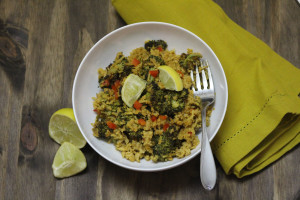
Spice Roasted Broccoli Casserole © 2015 Kiandra Jimenez

